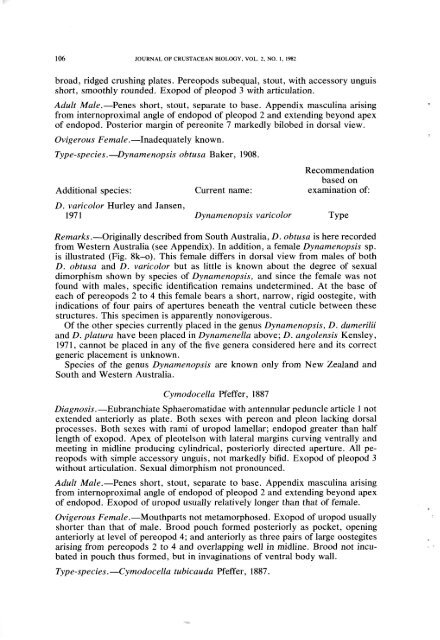Download PDF as one large file
Download PDF as one large file
Download PDF as one large file
Create successful ePaper yourself
Turn your PDF publications into a flip-book with our unique Google optimized e-Paper software.
106 JOURNAL OF CRUSTACEAN BIOLOGY, VOL. 2, NO. I, 1982<br />
broad, ridged crushing plates. Pereopods subequal, stout, with accessory unguis<br />
short, smoothly rounded. Exopod of pleopod 3 with articulation.<br />
Adult Male.—Penes short, stout, separate to b<strong>as</strong>e. Appendix m<strong>as</strong>culina arising<br />
from internoproximal angle of endopod of pleopod 2 and extending beyond apex<br />
of endopod. Posterior margin of pereonite 7 markedly bilobed in dorsal view.<br />
Ovigerous Female.—Inadequately known.<br />
Type-species.—Dynamenopsis obtusa Baker, 1908.<br />
Recommendation<br />
b<strong>as</strong>ed on<br />
Additional species: Current name: examination of:<br />
D. varicolor Hurley and Jansen,<br />
1971 Dynamenopsis varicolor Type<br />
Remarks.—Originally described from South Australia, D. obtusa is here recorded<br />
from Western Australia (see Appendix). In addition, a female Dynamenopsis sp.<br />
is illustrated (Fig. 8k-o). This female differs in dorsal view from males of both<br />
D. obtusa and D. varicolor but <strong>as</strong> little is known about the degree of sexual<br />
dimorphism shown by species of Dynamenopsis, and since the female w<strong>as</strong> not<br />
found with males, specific identification remains undetermined. At the b<strong>as</strong>e of<br />
each of pereopods 2 to 4 this female bears a short, narrow, rigid oostegite, with<br />
indications of four pairs of apertures beneath the ventral cuticle between these<br />
structures. This specimen is apparently nonovigerous.<br />
Of the other species currently placed in the genus Dynamenopsis, D. dumerilii<br />
and D. platura have been placed in Dynamenella above; D. angolensis Kensley,<br />
1971, cannot be placed in any of the five genera considered here and its correct<br />
generic placement is unknown.<br />
Species of the genus Dynamenopsis are known only from New Zealand and<br />
South and Western Australia.<br />
Cymodocella Pfeffer, 1887<br />
Diagnosis.—Eubranchiate Sphaeromatidae with antennular peduncle article 1 not<br />
extended anteriorly <strong>as</strong> plate. Both sexes with pereon and pleon lacking dorsal<br />
processes. Both sexes with rami of uropod lamellar; endopod greater than half<br />
length of exopod. Apex of pleotelson with lateral margins curving ventrally and<br />
meeting in midline producing cylindrical, posteriorly directed aperture. All pereopods<br />
with simple accessory unguis, not markedly bifid. Exopod of pleopod 3<br />
without articulation. Sexual dimorphism not pronounced.<br />
Adult Male.—Penes short, stout, separate to b<strong>as</strong>e. Appendix m<strong>as</strong>culina arising<br />
from internoproximal angle of endopod of pleopod 2 and extending beyond apex<br />
of endopod. Exopod of uropod usually relatively longer than that of female.<br />
Ovigerous Female.—Mouthparts not metamorphosed. Exopod of uropod usually<br />
shorter than that of male. Brood pouch formed posteriorly <strong>as</strong> pocket, opening<br />
anteriorly at level of pereopod 4; and anteriorly <strong>as</strong> three pairs of <strong>large</strong> oostegites<br />
arising from pereopods 2 to 4 and overlapping well in midline. Brood not incubated<br />
in pouch thus formed, but in invaginations of ventral body wall.<br />
Type-species.—Cymodocella tubicauda Pfeffer, 1887.

















